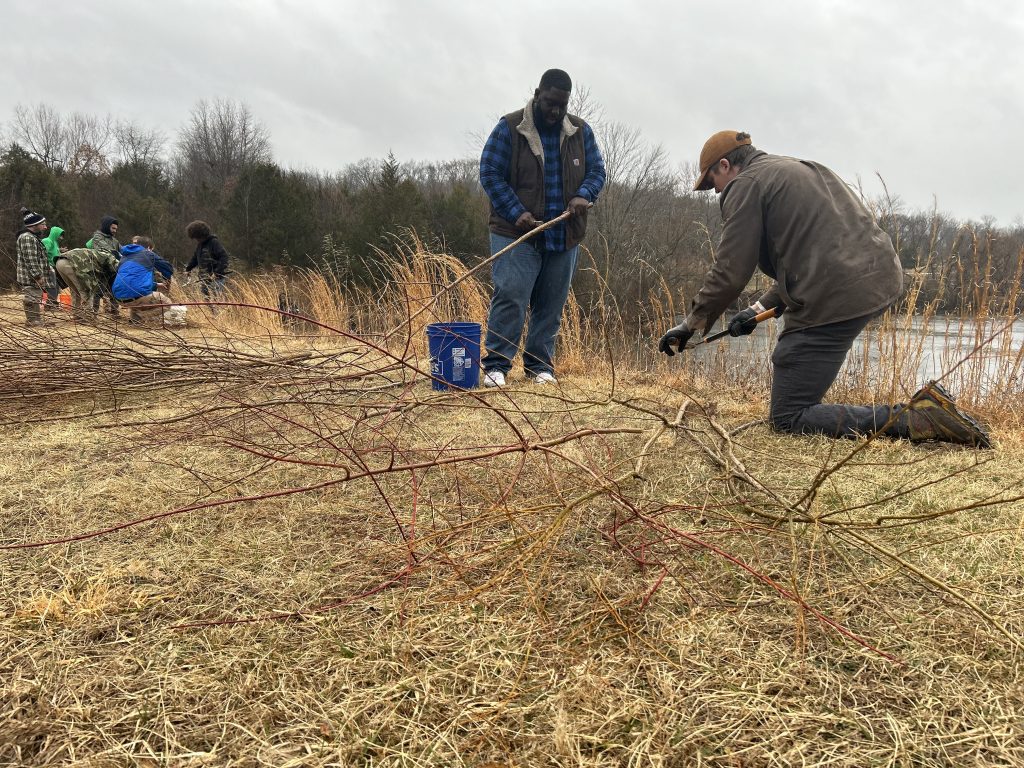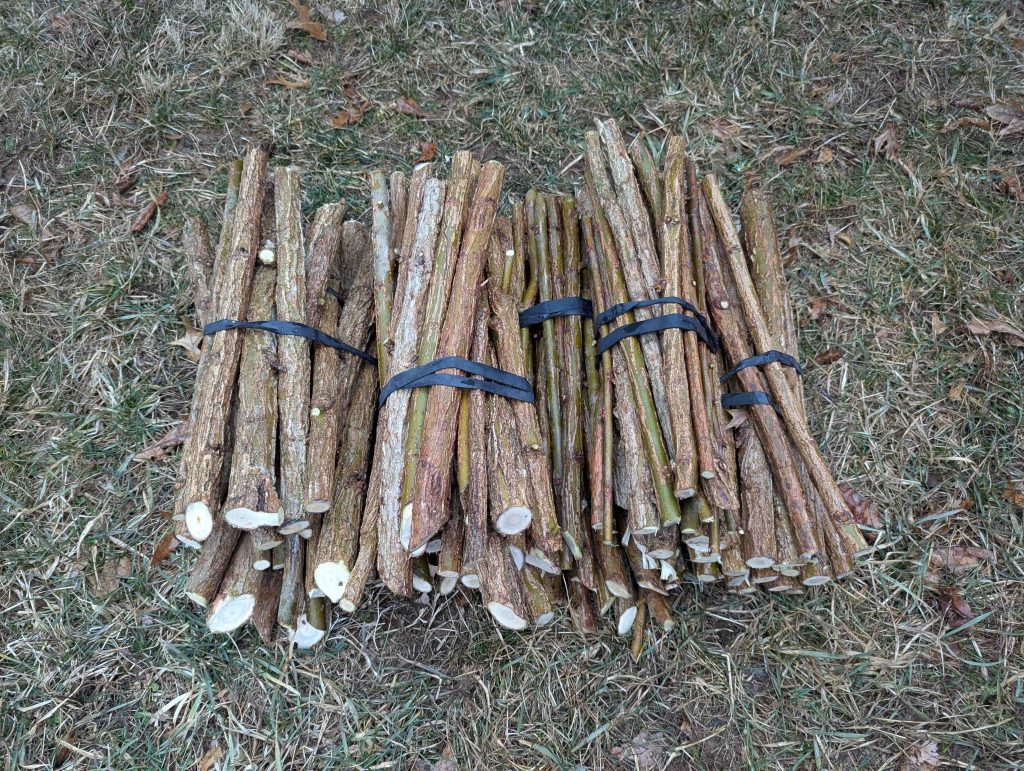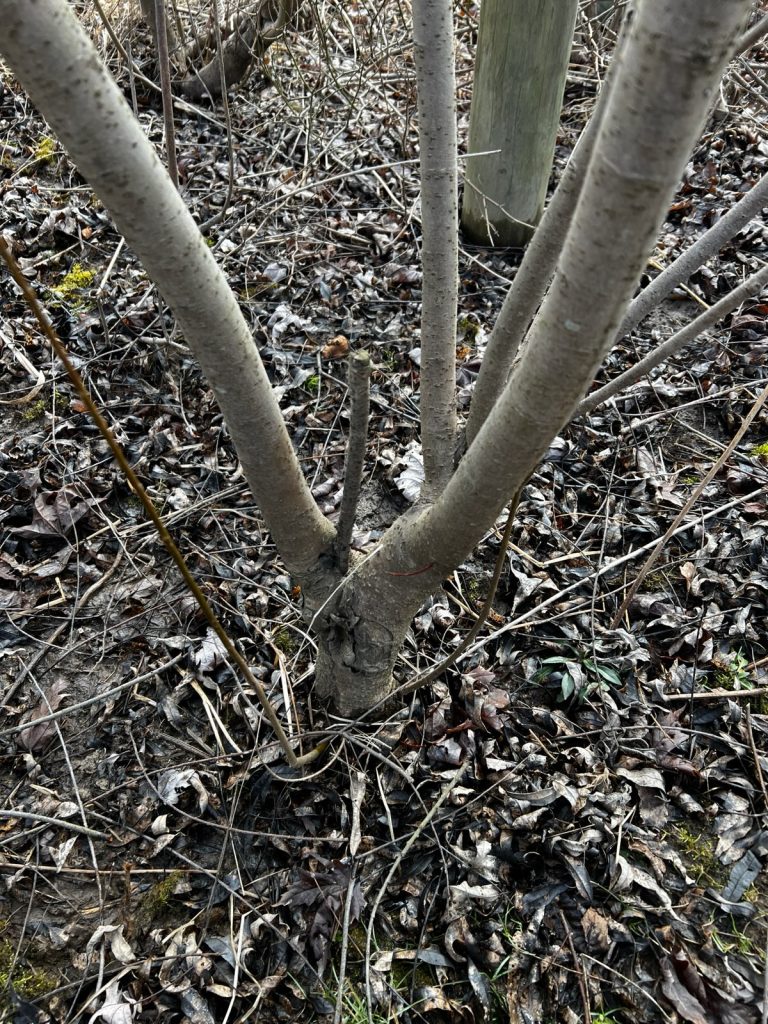Technique takes advantage of tree biology—try it in these wet areas

Participants in an environmental workforce training program snap branches off a dogwood to create live stakes. Parts of the branches will be planted as new trees. Photo by Winn Brewer/DNR
Trees are a great tool for restoration—they store carbon, provide habitat for wildlife, and prevent erosion with their root systems.
But some types of trees hold a trick within their biology that makes them even more effective, a kind of shortcut that allows people to quickly fill an area with new plantings.
“Trees are expensive,” said Zach Cline, live stake coordinator with the Chesapeake Conservancy. “Live staking is a great way to get them really cheap, and plant hundreds of trees with only a few hours of time.”
Rather than planting a seed or a sapling in the soil, live staking involves taking a cutting of a branch or stem and driving it into the ground. Each stake—they must still be alive, hence “live” staking—will then grow roots and eventually become an individual tree.
Though there’s something almost magical to full trees sprouting from stakes, the process is a longstanding technique that takes advantage of reproductive strategies of trees in areas of high disturbance. Cline said that trees such as willows and dogwoods evolved to propagate not only from seeds but also with stems and branches that take root when they fall off a tree.

Bundles of live stakes from willow trees sit ready to be stored and later planted. Photo by Joe Zimmermann/DNR
Live staking doesn’t work everywhere. It’s more successful with certain types of trees adapted to wetlands (willows, dogwoods, elderberry, buttonbush, alders, and sycamores) and in wetter areas where stakes can get a lot of moisture. Live stakes can be beneficial along streambanks, where they help against erosion, as well as for urban or agricultural areas.
With the right conditions, live staking can be very successful. Chesapeake Conservancy carries out live staking projects throughout the region, and they’ve had planting areas where 90 percent of stakes grow into trees, Cline said.
In March, the Maryland Department of Natural Resources hosted a live staking training event at Pearlstone Retreat Center, an environmental education center in Reisterstown, Baltimore County. The Chesapeake Conservancy led the training, which brought in staff and volunteers from several local organizations.
DNR and the Greater Baltimore Wilderness Coalition support a workforce development program called the Climate Crew Network. Emily Morrow, green jobs network coordinator with DNR’s Office of Outdoor Recreation, said these trainings are aimed at helping people gain skills for green jobs, but they also offer other benefits.
“Part of that workforce development is getting exposure to a lot of different environmental fields,” Morrow said. “So learning how to live stake might be environmental education and it might be community engagement, but it’s also showing people the value of being outside and why that’s good for your physical and mental health.”
At Pearlstone, the group geared up with pruners, loppers, and buckets, and descended a hill to a small impoundment pond. That day, the work of the trainees served a dual environmental purpose—as they gathered live stakes, they were also helping to clear cut an area where vegetation was impeding the function of the small dam.
When an area isn’t being clear cut, Cline said it’s best to take only a third of the mass of a tree or shrub. So if there are nine stems in the ground, take only three. That lets the trees easily grow back.
Using the loppers, the group cut off large stems of willows and dogwoods. Then, they pruned off smaller branches, so each stem became one long, straight stick. They placed the stick standing straight up in the 5-gallon bucket in order to cut it to about 1.5 feet, lopping a straight cut on the top and a diagonal cut on the bottom, where the stake will go into the ground. The stake should be about the width of a thumb.

When a live stake grows into a tree, the tree grows out from the base of the stake. Photo via Zach Cline
When the trees are ready to go into the ground, you can use a piece of rebar to make a hole, then drive in the stake, leaving between a half and a third of the stake above ground. Within days, the stake will sense wet soil and sprout roots. After a season, you might start to see additional growth, with more stems or buds branching out from the stake.
But until the stakes are ready for planting, they need to stay dormant. The Chesapeake Conservancy recommended keeping them refrigerated in closed bags filled with rice husks, which keeps the stakes humid without growing mold.
Sofia Reyes, a community impact coordinator with the Latino-led environmental nonprofit Defensores de la Cuenca, attended the training to be able to use the live staking for their own tree-planting projects.
“A major part of our work is to plant trees,” Reyes said, referring to their Embajadores de los Árboles program, where they plant 1,000 trees in the Chesapeake Bay watershed annually. “We can definitely use that skill [of live staking] and show our team as well how to use it in an effective way.”
Though the rain had held out during the stake collecting, a storm broke just as the group was binding up bundles of stakes for storage. As the wind and rain battered the trainee woodcutters, they worked together to stack piles by species and banded together sets of 100 stakes. By the end, they had stored more than 1,300 stakes—ready to be stored for a sunnier day. Several hundred supported a planting project in Columbia in April.
As the staff and trainees dried off inside at Pearlstone, Daniel Barondes, land stewardship and program associate at Pearlstone, compared the work to a mitzvah, or a blessing, for the land around them that can be carried forward to another planting.
“What we did is one of the best things you can do for the land, so thank you,” Barondes said.
By Joe Zimmermann, science writer with the Maryland Department of Natural Resources

